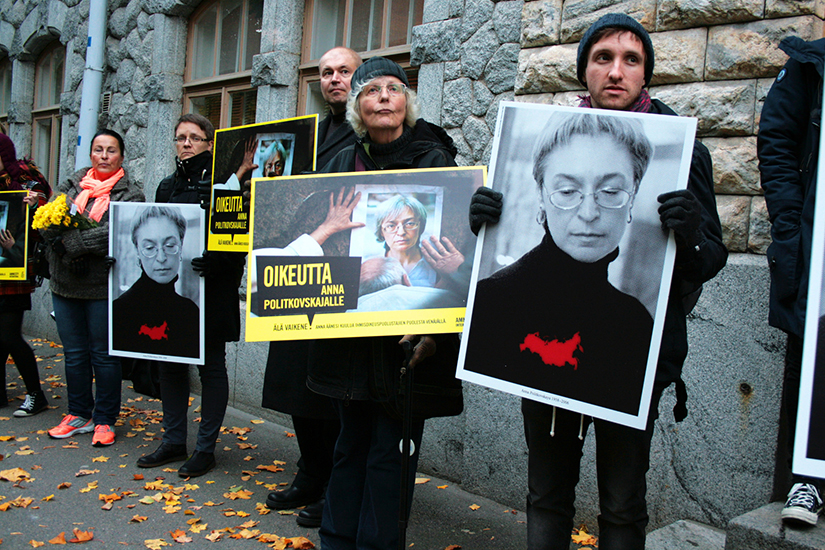
Journalists are often an irritant to governments and people with power. Seventy-nine died doing their jobs around the world in 2016. Few were globetrotting foreign correspondents. Most were, instead, local reporters – often writing about local politics. According to a new study in the Journal of Peace Research, these murders are a warning, an indication that political repression and rights abuses may be imminent.
“If a journalist is killed, state repression is significantly more likely to deteriorate in the following two years – particularly in countries that previously displayed low levels of repression,” says the study by Anita Gohdes of the University of Zurich and Sabine Carey of the University of Mannheim, in Germany. They liken murdered journalists to the canaries in a coal mine that drop dead from invisible toxic gases: Their deaths are harbingers of a danger that will affect everyone in the country. The trend is more observable, Gohdes and Carey find, in countries that currently experience only limited forms of repression, where future repression is otherwise hard to predict.
Gohdes and Carey collect data on the number of journalists killed by country between 2002 and 2013 by comparing figures from three established watchdogs: The Committee to Protect Journalists, Reporters Without Borders and the International Press Institute. They find 93 percent of the victims were local reporters. After trying to establish the perpetrators’ identities – which is often impossible – they look at where the country lands the following two years on the Political Terror Scale (PTS), a widely cited measure developed by academics that measures government repression.
Of course, journalists are not only killed by repressive regimes, but also by those whose illegal activities they cast light on. Many, too, die in conflicts.
The authors identify four types of perpetrators: 1) The state or anyone operating with a wink and nod from a senior official; 2) non-state political actors, such as extremist groups (al Qaeda, for example) or rebels (FARC in Colombia); 3) non-political criminals or gangs; and most often, 4) the perpetrator is unconfirmed (the authors assume the majority of these are carried out by a state actor). The authors do not consider journalists killed in accidents in their analysis. Some findings:
- The murder of a journalist by a government-sponsored actor is a “significant indicator” that human rights will deteriorate within two years.
- Murders by a government-sponsored actor or an unknown perpetrator “are not only significantly associated with higher levels of repression two years into the future, but also already in the following year.”
- When a non-state political group (such as al Qaeda) kills a journalist, “the government is significantly more likely to increase its level of repression” within the first year — often in response to this upstart challenging the state’s monopoly on violence.
- When a non-political actor, such as a criminal gang, kills a journalist, repression increases, but slowly. The authors explain: “Instability due to crime is likely to be seen as less threatening [to the state] than instability resulting from armed political groups.”
- The authors find that countries with established democratic traditions and higher levels of economic development are associated with less repression. They also find that armed conflict is “significantly correlated with increased repression.”
Gohdes and Carey believe that the killing of a journalist does not change how a country is coded on the PTS scale – that the coding is not driven by the murders themselves – because the “overwhelming majority of journalists killed work for locally owned news outlets and the perpetrators remain unconfirmed. These cases receive little attention, and due to lack of evidence, governments are not held accountable.”
Other resources:
As mentioned above, the authors took their data on journalist deaths from three organizations that advocate for journalists’ safety:
- The Committee to Protect Journalists profiles every murder of a journalist around the world every year. CPJ estimates that 1,236 journalists have been killed since 1992, when it began its count.
- Reporters Without Borders publishes a widely cited index measuring press freedom around the globe.
- The International Press Institute highlights and lobbies specific press-freedom concerns, such as efforts in Turkey to jail journalists and editors at a top independent newspaper.
The Political Terror Scale publishes its data and sources here.
The Rory Peck Trust advises journalists on safety and offers freelancers grants to fund hostile-environment training.
Journalist’s Resource has published tip sheets on digital security for journalists, staying safe in any beat, and best practices that independent documentary filmmakers can employ to protect themselves.
This 2013 paper in Journalism and Mass Communication Quarterly examines how reporters in El Paso cover violence in neighboring Ciudad Juarez, right over the border in Mexico.
